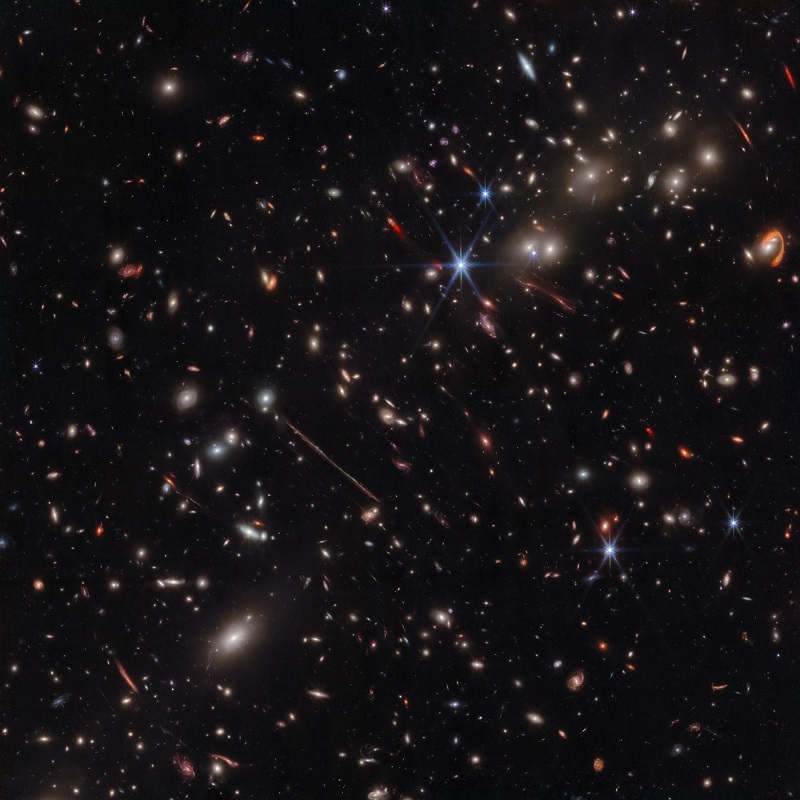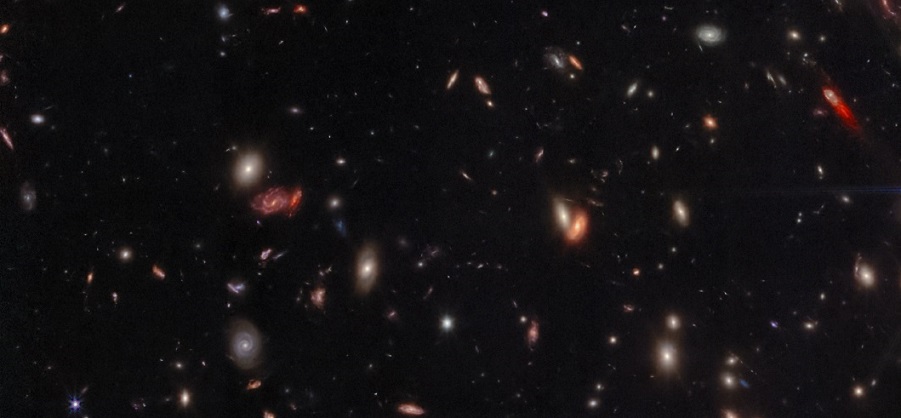The Fishhook. The Thin One. These are just two of the striking targets revealed in new detail by NASA’s James Webb Space Telescope. Webb observed
The Fishhook. The Thin One. These are just two of the striking targets revealed in new detail by NASA’s James Webb Space Telescope.
Webb observed El Gordo, a galaxy cluster that existed 6.2 billion years after the big bang. It was selected as the most massive galaxy cluster known at that time in cosmic history, reported NASA.

Galaxy clusters are the heavyweights of astronomy. They have the power to bend and magnify light from more distant objects, a phenomenon known as gravitational lensing that was predicted by Albert Einstein more than 100 years ago. Webb’s infrared image of El Gordo displays a variety of unusual, distorted background galaxies. It also has fueled several new scientific discoveries, reported NASA.
This image of “El Gordo” is revealing distant and dusty objects never seen before, and providing a bounty of fresh science. The infrared image, taken by NASA’s James Webb Space Telescope, displays a variety of unusual, distorted background galaxies that were only hinted at in previous Hubble Space Telescope images.
El Gordo is a “cosmic teenager”. (“El Gordo” is Spanish for the “Fat One.”)

The team targeted El Gordo because it acts as a natural, cosmic magnifying glass through a phenomenon known as gravitational lensing. Its powerful gravity bends and distorts the light of objects lying behind it, much like an eyeglass lens, reported NASA.
“Lensing by El Gordo boosts the brightness and magnifies the sizes of distant galaxies. This lensing effect provides a unique window into the distant universe,” said Brenda Frye of the University of Arizona. Frye is co-lead of the PEARLS-Clusters branch of the Prime Extragalactic Areas for Reionization and Lensing Science (PEARLS) team.
Within the image of El Gordo, one of the most striking features is a bright arc represented in red at upper right. Nicknamed “El Anzuelo” (The Fishhook) by one of Frye’s students, the light from this galaxy took 10.6 billion years to reach Earth. Its distinctive red color is due to a combination of reddening from dust within the galaxy itself and cosmological redshift due to its extreme distance, reported NASA.

By correcting for the distortions created by lensing, the team was able to determine that the background galaxy is disk-shaped but only 26,000 light-years in diameter, about one-fourth the size of the Milky Way. They also were able to study the galaxy’s star formation history.
Another prominent feature in the Webb image is a long, pencil-thin line at left of center. Known as “La Flaca” (the Thin One), it is another lensed background galaxy whose light also took nearly 11 billion years to reach Earth, reported NASA.

Not far from La Flaca is another lensed galaxy. When the researchers examined that galaxy closely, they found three images of a single red giant star that they nicknamed Quyllur, which is the Quechua term for star.
Quyllur is the first individual red giant star observed beyond 1 billion light-years from Earth. Such stars at high redshift are only detectable using the infrared filters and sensitivity of Webb, reported NASA.
“It’s almost impossible to see lensed red giant stars unless you go into the infrared. This is the first one we’ve found with Webb, but we expect there will be many more to come,” said Jose Diego of the Instituto de Fisica de Cantabria in Spain, lead author of a third paper on El Gordo.

Other objects within the Webb image, while less prominent, are equally interesting scientifically. For example, Frye and her team identified five multiply lensed galaxies that appear to be a baby galaxy cluster forming about 12.1 billion years ago, reported NASA.
There are another dozen candidate galaxies that may also be part of this distant cluster.
A final paper examines very faint, smudge-like galaxies known as ultra-diffuse galaxies. As their name suggests, these objects, which are scattered throughout the El Gordo cluster, have their stars widely spread out across space. The team identified some of the most distant ultra-diffuse galaxies ever observed, whose light traveled 7.2 billion years to reach us, reported NASA.

“Gravitational lensing was predicted by Albert Einstein more than 100 years ago. In the El Gordo cluster, we see the power of gravitational lensing in action,” concluded Rogier Windhorst of Arizona State University, principal investigator of the PEARLS program. “The PEARLS images of El Gordo are out-of-this-world beautiful. And, they have shown us how Webb can unlock Einstein’s treasure chest”, as reported by NASA
All Credit: NASA, ESA, CSA. Christine Pulliam. Space Telescope Science Institute, Baltimore, Maryland


